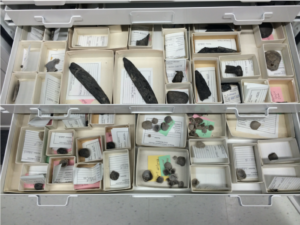Currently the Department of Geology and Paleontology Laboratory maintains a teaching collection of invertebrate, vertebrate and plant fossils numbering more than 10,000 individual specimens. These specimens are used in a several of courses including Invertebrate Paleontology and Historical Geology. Many of these are featured on the web based paleontology tutorial that accompanies the invertebrate paleontology course.
 In addition to the teaching collection, the Paleontology Lab is home to more than 10,000 individual fossil specimens that are used for research purposes. A large portion of this material are fossil invertebrates, mostly marine bivalve molluscs, from the Triassic Period. A significant proportion of the research collection comes from the Alpine region of Europe (Germany, Austria, Switzerland, and Italy), England, and from the western part of North and Central America including Alaska, British Columbia, Oregon, Idaho, Utah, Nevada, and Sonora Mexico. At any one time, additional fossil material is on loan from other repositories such as the Smithsonian Institution and the American Museum of Natural History.
In addition to the teaching collection, the Paleontology Lab is home to more than 10,000 individual fossil specimens that are used for research purposes. A large portion of this material are fossil invertebrates, mostly marine bivalve molluscs, from the Triassic Period. A significant proportion of the research collection comes from the Alpine region of Europe (Germany, Austria, Switzerland, and Italy), England, and from the western part of North and Central America including Alaska, British Columbia, Oregon, Idaho, Utah, Nevada, and Sonora Mexico. At any one time, additional fossil material is on loan from other repositories such as the Smithsonian Institution and the American Museum of Natural History.